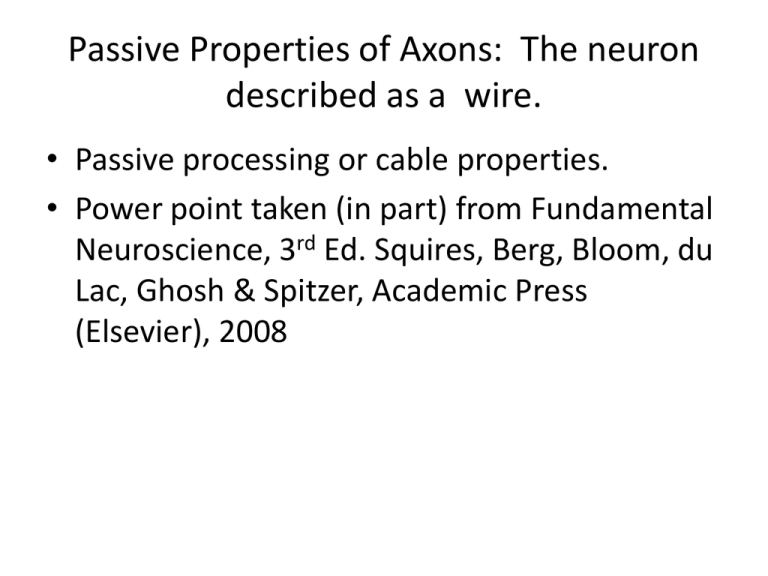Passive Cable Properties of Axons
advertisement

Passive Properties of Axons: The neuron described as a wire. • Passive processing or cable properties. • Power point taken (in part) from Fundamental Neuroscience, 3rd Ed. Squires, Berg, Bloom, du Lac, Ghosh & Spitzer, Academic Press (Elsevier), 2008 Areas of Neural Processing 1) Generate intrinsic activity • At any given sight in the neuron intrinsic activity can be generated through voltagedependant membrane properties and internal second messenger mechanisms. 2) Receive synaptic input • Occurs mostly in dendrites, to some extent in cell bodies, and in some cases in axon hillocks, initial segments, and axons 3) Integrate signals by combining synapticresponses with intrinsic membrane activity • Occurs in dendrites, cell bodies, axon hillocks and initial axon segments. 4) Encodes output patterns in graded potentials or action potentials • Happens at any given site in the neuron. 5) Distribute synaptic outputs • Occurs at axon terminals and, in some cases, from cell bodies and dendrites. Toward a theory of neuronal information processing • The basic tool: Understanding cable theory and compartmental models Spread Of Stead-State Signals • Are main interest is in the rapid spread of electric current. • This spread of current is called electrotonic properties • There are 11 assumptions about this spread of potentials that are not always explicitly acknowledged. • The neuron can be compartmetnalized. A given segment or compartment of a neuron (1) Segments are cylinders • A segments is assumed to be a cylinder with constant radius The electrotonic potential is due to a change in the membrane potential • AT any instant in time the “resting” membrane potential (Er) at any point on the neuron can be changed by several means: • (a) injection of current into the neuron • (b) extracellular currents that cross the • membrane • (c) changes in membrane conductance • (different from that responsible for the • membrane potential) 2 (cont.) • Neurobiologist do not believe the membrane is ever “at rest”. “At rest” practically speaking means any potential not including action potentials and rapid synaptic potentials. 3) Electrotonic current is ohmic • Passive eletrotonic current flow is usually assumed to be ohmic; follows ohms law; • E = IR • Where E is the potential (in volts), I is the current (in amps) and R is resistance (in ohms). 3 (cont.) • The membrane following ohms law is inferred from macroscopic measurements of conductance of solutions having compositions of intracellular mediums. Rarely is this tested for a given neuron. 3 (cont) • Largely untested is the likelihood that at the smallest dimensions (0.1μm diameter or less) the processes and their internal organelles may acquire submicroscopic electrochemical properties that deviate significantly from macroscopic fluid conductance values. • Modeling the neuron into compartments allows for estimates of these properties in conductance terms. 4) In the steady state, membrane capacitance is ignored. • The simplest case of electrotonic spread occurs from the point on the membrane of a steady state change (e.g., due to injection current, a change in synaptic conductance, or a change in voltage-gated conductance) so that time varying properties (transient charging or discharging of the membrane) due to the capacitive current can be ignored. 5) The resting membrane potential can usually be ignored • In the simplest case we consider the spread of electrotonic potential (V) relative to a uniform resting potential (Er) such that the resting potential can be ignored. • Where the resting membrane potential may vary spatially, V must be defined for each segment as • V = Em - Vr 6) Electronic current divides between internal and membrane resistances. • In the steady state, at any point on a process, current divides into two local resistance paths: further within the process through an internal (axial) resistance (ri) or across the membrane through a membrane resistance (rm). 7) Axial current is inversely proportional to diameter • Basically, this say as the diameter increases the resistance decreases. • Because the axial resistance (ri) is assumed to be uniform throughout the process, the total cross-sectional axial resistance of a segment is represented by a single resistance, • ri = Ri/A (7 cont) • Where ri is the internal resistance per unit length of ri cylinder (in ohms per centimeter of axial length), Ri is the specific internal resistance (in ohms centimeter, or ohms cm), and A (= πr2 ) is the cross-sectional area. (7 cont.) • In voltage clamp experiments, the space clamp eliminates current through ri so that the only current remaining is through rm there by permitting isolation and analysis of different ionic membrane conductances. As in the original H & H studies. A given segment or compartment of a neuron 8) Membrane current is inversely proportional to membrane surface area. For a unit length of cylinder, the membrane current (im) and the membrane resistance (rm) are assumed to be uniform over the entire surface. Using the summing rule for parallel resistances, the membrane current is inversely proportional to the membrane area of the segment so that a thicker process has a lower overall membrane resistance. Thus • a thicker process has a lower overall membrane resistance. Thus, • rm = Rm/c 8 cont. • where rm is the membrane resistance for unit length of the cylinder (in ohms cm of axial length), Rm is the specific membrane resistance (in ohms cm) and c (= 2πr) is the circumference of the cylinder. • Membrane resistance is considered a point; that is no axial flow within a segment only between segments 8 cont. • Membrane current passes through ion channels in the membrane. The density and types of channels of channels vary in different processes and may vary locally in different segments and branches. These differences are incorporated into compartmental representations of the processes. 9) The external medium along the process is assumed to have zero resistivity • In contrast to the internal axial resistance (ri) which is relatively high because of the small dimensions of most nerve processes, the external medium has a relatively low resistivity for current because of its relatively large volume. For this reason the resistivity of the paths either along a process or to ground generally is regarded as negligible and the potential outside the membrane is assumed to be everywhere equivalent to ground. 10) Driving forces on membrane conductances are assumed to be constant • Only in small restricted compartments, either extracellular or intracellular, would this assumption not hold true. 11) Cables have different boundary conditions • The relatively short length of spines and dendrites impose boundary conditions on solutions when apply cable theory to neurons. • The boundary conditions impose significantly effect on e lectronic spread. Characteristic length, or space constant (λ), of a fiber (axon) • The question is; what is the spread of the current down a axon from the site of the input? • Standard cable theory uses the relationship of: • V = (rm/ri) (d2V/dx2) • Given the stead state with input at point x = 0, the electrotonic potential (V) spreads along the cable is proportional to the second derivative of the potential (d2V) with respect to distance and the ratio of the membrane resistance (rm) to the internal resistance (ri) • Space Constant (cont) • over that distance. • The steady-state solution of the equation for a cable of infinite length and positive values of x is • V = Voe-x/λ • Where lambda is defined as the square root of rm/ri (in centimeters) and Vo is the value at x= 0 • The solution is relatively easy. Note when x = λ, -x/λ = -1, the ratio of V to Vo is e-1 = 1/e = 0.37. • Lambda is a crititcal parameter defining the length over which the electrotonic potential will spread along a cable of infinite length. Lambda is the characteristic length or space constant of the spread of the potential. Space constant and real axons • Because of the open passive channels of axons or other parts of the neuron and the constant activity of the neuron the electrotonic current can be carried through many open channels. The effective Rm can vary from less than 1000Ω cm2 to more than 1000,000Ω cm2 in different neurons or parts of neurons. • The space constant λ depends not only on the internal and membrane resistance, but also on the diameter of the process, or Resistance changes, change lambda • λ = (rm/ri)1/2 = ((Rm/Ri) (d/4))1/2 • (see assumption 7). Three different space constants that very because of specific internal resistance changes. Diameter changes that effect lambda • • • • Increasing the diameter, significantly changes λ Summary of space constant λ • The key to understanding the space constant λ, is understanding that time is allowed to vary. The only variable held constant is the amplitude of the current. If the current’s amplitude is considered 1.0 at the place of injection, λ will be the length between where the current started and the spot where the current has fallen to 0.37. Distinguish between “spread of a current’ vis-avi propagation of the action potential. • • • • Spread of current is passive. Propagation means active regeneration. An action potential can be called a ‘transient” (temporary) signal Time constant of “transient” signals depends on membrane capacitance • In the compartmental model of the axon, the electrical equivalent circuit places the membrane capacitance in parallel with ohmic components (conductance of Na and K) and the driving potentials for ion flows through those components. Neglecting the resting membrane potential, inject a current into the soma of a neuron: The time course of the current spread to ground is described by the sum of capacitative and resistive currents, plus the input current, Ipulse Time constants mathematics • That is: • C(dVm/dt) +Vm/R = Ipulse • Rearranging for R gives: • RC(dVm/dt) = Vm = (Ipulse) (R) • Where RC = τ (τ is the time constant of the membrane). • The solution of this equation though simple mathematically is not necessary for this class. The significance of tau • The significance of tau is shown in the next slide; it is the time required for the voltage change across the membrane to reach 1/e = 0.37 of its final value. This time constant of the membrane defines the transient voltage response of a segment of the membrane to a current step in terms of the electrotonic properties of the segment. It is analogous to the way that the length constant defines the spread of voltage over distance. Time constant (cont.) • Transient signals are oscillating signal that is “on”/”off” signals. The RC in the equation means it has resistive and capacitive components which turn on then off. Change in voltage to 1/e Applying tau to a two compartment model • Assume current is injected into compartment A. • Positive charges in comp. A attempt to flow outward across the membrane partially opposing the negative charge on the inside of the lipid membrane • This depolarizes the membrane capacitance (Cm) at that site. • At the same time the charge begins to flow as current across the membrane through the resistance channels of the ionic membrane (Rm) at that site. Compartmental analysis of tau (cont.) • The proportion of charge divided between Cm and Rm determines the rate of charge of the membrane, that is the membrane constant τ(tau). • Charge also starts to flow through internal resistance Ri in to compartment B where the current again divides between capacitance and resistance. • The charging and discharging of compartment A changes τ, being faster, because of the of the impedance (resistance and capacitance) load in compartment B is smaller than that of compartment A. Thus the time constant is not the same as the Time constant (cont.) • beginning when only compartment A was considered. • Impedance measures are used only in in currents and voltages that oscillate (will have a Hz when describing the system). •








